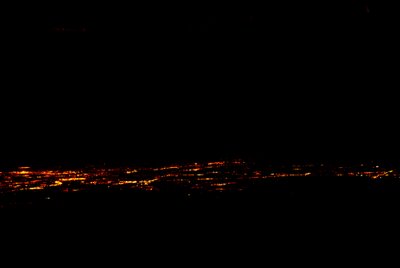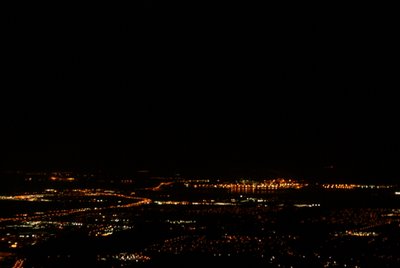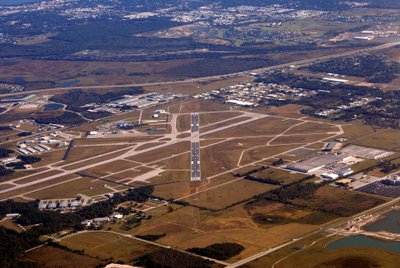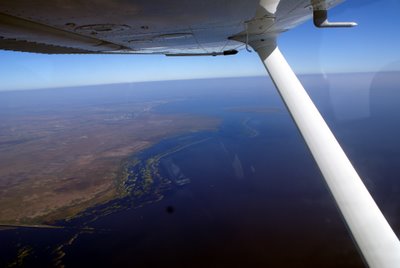We loaded up and were ready to go very close to our departure time. I taxied to the runup area and contacted Palm Beach Clearance Delivery.
"Palm Beach Clearance Delivery, Skyhawk 1-4-6-3-Foxtrot, ready to copy IFR to Charlie-Romeo-Golf, holding short of runway 3-1.", I announced.
Nothing.
Oops, wrong frequency. I corrected the frequency and called again.
This time, the response came, "Who's calling clearance delivery?"
I repeated myself and was told that he didn't have anything for me. It seemed strange that he didn't have to spend too much time looking for my plan, so I told him I had filed about 45 minutes ago on line.
"Well, I can give you VFR flight following and you can contact the Miami Flight Service Station at 122.4 or 122.2 and refile with them."
I was sitting with my engine running and I'd have to file over the radio...lovely.
I changed the radio frequency to 122.4 and called, "Miami Radio, Skyhawk 1-4-6-3-Foxtrot."
A garbled crackle was my only response, so I called again. A near perfect duplicate of the original garbled crackle came through my headset.
"Great.", I thought to myself, "I've got an overcast ceiling and I can't file an IFR plan on the ground without shutting down and getting on the phone."
I tuned Palm Beach clearance again and called them up. The controller said he would call when my clearance comes up. This posed a dilemna for me since the only way it would come up would be if my original clearance magically appeared. I decided to avoid clearance delivery and file in the air with the FSS.
I verified that the Vero Beach VOR was my direct to in my GPS and I announced my departure on runway 31. At 500', I began my turn towards VRB and continued my climb towards 2000'. As I climbed, I heard a multi-engine aircraft announce their position to the north of F45 southbound descending for a full stop. I could see his lights in the distance.
I announced my departure to the north on the CTAF and the twin pilot called me, "Traffic departing North County, what's your position? Do you have your landing lights on?".
I responded, "I'm direct Vero out of 1,500 for 2,000. I think I've got your lights in sight. I'll flash mine for you." And I flashed the landing lights.
"Ok, I've got you in sight. I'll turn a little eastward and I'll pass you to the East.", the twin advised.
"Thanks. I see you passing. Have a nice evening", I said.
After this encounter, I called the Miami FSS saying "Miami Center, Skyhawk 1-4-6-3-Foxtrot".
As soon as the words were out of my mouth, I knew I called the target by the wrong name.
"This is the Miami Flight Service Station, can I help you?", announced the FSS contact.
"Sorry. That's what I meant to say. I filed an IFR plan that seems to have been lost. Can I file with you?", I humbly begged.
"Sure. What's your type of aircraft and equipment?", he asked.
We then went back and forth through the full flight plan procedure ultimately culminating with a "You're on file. If you feel like giving a PIREP, please call Flight Watch at 122.0".
I thanked the very patient controller and contacted Palm Beach Approach, "Palm Beach Approach, Skyhawk 1-4-6-3-Foxtrot, with request".
Immediately a very nice sounding lady told me that I was cleared to CRG, squawk 3734 and to climb to 7000'.
I began my climb through the overcast layer. It got a bit bumpy on the climb, but I maintained level flight throughout the climb. We broke out of the clouds around 6600' and there was a very stable layer of clouds only 400' beneath us.
A few minutes later, I was handed off to Miami Center. The center controller told me he had my clearance and I should advise when ready to copy. This seemed odd since I had received clearance from the PB controller, but considering the problems so far, I was not about to argue.
"Cleared direct MLB then Victor 3 to OMN, then V51 to CRG", he announced.
I was already direct VRB, so getting cleared beyond that made life a bit simpler. I repeated my clearance and settled in for a smooth flight.
There was almost no moon to illuminate the cloud layer that undulated below me. At times, towering cumulous clouds jutted into our path tossing the plane with surprising force. At other times, the cloud layer slowly rose in unison above our cruising altitude ever so briefly before retreating to a stable distance about 500' below us. The traffic system was alive now pointing out all traffic within 3500 feet vertically and about 10 miles horizontally. It is always fun when a controller points out traffic and I can reply, I've got him on my scope and in sight.
I tried to take a few pictures of the clouds below, but low light made them very grainy. I'll post one just to show the view...

We cruised along making about 110 knots of groundspeed with a decent headwind. True Airspeed was around 118 knots. The traffic system showed a plane 2000' below us heading in roughly the same direction at close to the same speed. He was actually several miles to the West of the airway and weaved left and right quite a bit. At one point, his altitude reported within 1500' of us. Thinking that another aircraft flying at our altitude towards the same destination might cause me some delay getting down, I decided to up the power a bit. I pushed the throttle until the engine was making 2600 RPM and readjusted the mixture. We trimmed out at 122 knots TAS and started making about 116 knots of groundspeed - give or take a knot. Through periodic gaps in the clouds I could see the aircraft below me just to the left of my course. Slowly we passed him until he disappeared from the scope altogether.
During this time, I managed to snap a photo of the lights of Orlando. There's really not much to see. The lights kind of look like lava flows to me.

With a solid layer of overcast below us, we passed over OMN. Shortly afterwards, the Daytona Approach Controller called, "November 6-3-Foxtrot, it is now clear down to 5000, you'll need to be down in about 40 miles, would you like to descend?"
I responded, "6-3-foxtrot, If it isn't a problem, I'd prefer to remain at 7000. We are in smooth air above the clouds and we still have about 65 miles to go."
"November 6-3-Foxtrot, remain at 7000 as requested", he replied.
So on we cruised in smooth air as the cloud layer below us diminished. We were almost clear of clouds when we approached St. Augustine.

Lights of St. Augustine descending from 7000' northbound.
I called Jacksonville Approach and requested lower. The controller cleared me down to 3000' and I began my descent. During the descent, I shot a few photos of St. Augustine - It's amazing what you have time to do when you establish a nice, stable descent. Most of the shots are a bit blurry. The shutter speed had to be fairly slow to get the light, so even the slightest motion resulted in blurred images. Nevertheless, I managed to get one that wasn't totally blurry.
As we approached CRG, I also shot the following picture. You can see the Blount Island lights in the center of the shot as they reflect off of the St. Johns River. The curving line that comes from the bottom left then curls back again to the left is highway 9A. The line with the hump is the Dames Point Bridge.

Craig was landing VFR on runway 5 and when we were about 12 miles out, I advised ATC that I had CRG in sight. I had listened to the ATIS on the second radio and contacted the tower when Jax Approach handed me off. I was advised to make a right base for runway 5 and I set up a steady, slow descent.
Runway 5 is the closest runway to Sterling and if I could stop by the Bravo-2 taxiway, I would cut off a significant part of my taxi time. Therefore, I set up for a short field landing. Winds were calm, so I maintained 65 knots on approach with my hand on the throttle so I could gas it should a gust cause my airspeed to drop. I aimed at the numbers and pulled the power to idle. I flared above the numbers and landed just beyond them. I maintained full backpressure on the yoke and retracted the flaps as soon as I touched down. Confident that we weren't going to bounce, I applied the brakes and we slowed to a crawl in time to make the Bravo-2 cutoff.
Upon seeing me turn off, the tower advised me to taxi to the ramp and monitor ground on "point 8", which means monitor the ground control frequency on 121.8.
I acknowledged and said good night as we taxied to our parking spot. Just before shutting down, the radio announced that the tower was closed and would reopen in the morning....It was now 11PM. Our flight had taken a little over 2 hours due to the extra time on the ground monkeying around with the flight plan. I got a fair amount of instrument time in at the beginning as most of our climbout was spent in the clouds and we popped in and out for the first hour of the ride. Overall the flight was very smooth and enjoyable.
Seven years ago, we made the same trip by car...maybe for Christmas, I don't recall exactly. We had a nearly 4 hour ride to Tampa followed by a similar ride to Palm Beach Gardens and capped off by a nearly 4 hour ride from PBG to Jacksonville. At the end of that trip I remember saying I would never spend that much time on a holiday weekend fighting traffic. Having a pilot's certificate makes a huge difference. We spent much less time in transit. Our time was spent free of traffic relaxing in the air thanks to a terrific autopilot and a wonderful aircraft. Maureen even watched TV on my IPOD during the flight - something she would never dream of doing in a car.
Life is Good!
David West


 The dark spot near the bottom of the shot is a mote on my camera lens.
The dark spot near the bottom of the shot is a mote on my camera lens. 

